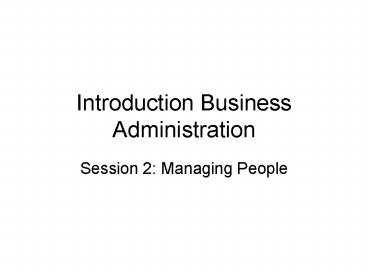Introduction Business Administration - PowerPoint PPT Presentation
1 / 20
Title:
Introduction Business Administration
Description:
Break down all barriers between staff areas ... Organizations consist of groups of people who work together in several constellations over time. ... – PowerPoint PPT presentation
Number of Views:8982
Avg rating:3.0/5.0
Title: Introduction Business Administration
1
Introduction Business Administration
- Session 2 Managing People
2
Fords improvementthe assembly line
- Ford improved the primary process of producing
cars from a project lay out to product lay out
They lay out of the plant was optimized for the
product an production line. - What did this mean for the workers?
- What did this mean for their managers?
3
Workers/Managers
- Workers specialize to become more efficient
- Managers manage to improve efficiency of workers
(procedures, pauses, control) - Paradigm Humans are machines and can be
programmed.
4
Hawthorne experiments
- Conditions of workers were changed frequently,
more autonomy - Productivity increased..temporarily
- It was the attention not the changes that
improved productivity. - Managing is about human relationships.
5
Positive versus negative incentives
- Many management concepts are based on the idea of
controlling whether people are doing things
right, rather than on trying to stimulating them
to do it right. - Demings Total Quality Management approach took
the positive approach
6
Demings 14 points
- Constancy of purpose for improvement
- Adopt the new philosophy
- Cease dependency on mass inspection
- End the practice of awarding business on the
price tag alone - Improve constantly and forever the system of
production and service - Institute job training and retraining
- Institute leadership
7
Demings 14 points (continued)
- Drive out fear
- Break down all barriers between staff areas
- Eliminate slogans, exhortations, targets for the
work force - Eliminate numerical quotas
- Remove barriers to pride of workmanship
- Institute a vigorous program of education and
retraining - Take action to accomplish the transformation
8
Motivating people
- ERG theory Existence, Relationships, Growth.
- ? Manage on ERG needs
- Equity theory ratio of persons inputs to
outcomes, compared to a relevant other person - ? Manage on understanding group dynamics
9
Authority relationships
- Yale experiment
- Boss encouraging teacher to use electro-
shocks to train a pupil - Teacher test person teaching with punishment by
electroshocks of increasing voltage (up to 450
volt) - Pupil professional actor simulating painfull
responses to shocks
10
Result of test
- More than 50 of test persons exercised shocks to
maximum of 450 volt after encouragement by boss,
despite being informed of possible results. - Respecting authority is a very natural
relationship attitude. - Very useful in large organizations.
- Bad when innovation and disobedience is required.
11
Employer Employee relationship
- Traditional view
- Employer has a authority hierarchy
- Employee works hard and gets rewarded
- Contemporary view
- Employer and Employee have a common goal, or
- Employer guarantees employability
- ? These new views are needed in the quickly
- changing environment of the global economy!
12
Groups and Teams
- The 5 phases of group development
- Forming ? testing each other out
- Storming ? fight for power
- Norming ? setting up norms
- Performing ? do the real work
- Adjourning ? sharing credits
13
Groups Teams
- Organizations consist of groups of people who
work together in several constellations over
time. - Unsuccessful groups are groups that have not
completed one of the previous steps. - Self organizing teams (Deming!) are groups that
organize and manage themselves to reach a common
goal.
14
Organizational level
- Traditional view
- Choose an organizational design that fits the
strategic direction of the company - Current view Choose an organizational design
that facilitates - 1. change
- 2. organizational learning
15
Managing change
- Create a sense of urgency
- Create a guiding coalition
- Develop a vision and strategy
- Communicate the changed vision
- Empower broad based action
- Generate short term wins
- Consolidate gains
- Anchor new approaches in the culture
16
Organizations that went to a significant change
- General Motors, after being under attack from
Japanese Car Manufacturers (Deming) - ABP, needing to change from a public institution
to a competitive firm - Oce, changing from a nationally oriented firm,
towards a customer focused supply chain operator.
17
Human Resource Management
- Entry and exit processes
- Growth and development of employees
- Reward and recognition systems
- How people are treated
18
Entry and exit
- Hiring is easy....?
- Mix of work force
- Gender based issues ( management training
programs, day care centers) - Exit strategies in big lay offs
- Outsourcing non core activities
19
Growth and development
- Less management means less promotion
opportunities - Growth and development can be in terms of
knowledge ? in company training programs - Development into ownership, GE and Walmart
20
Guidelines for managing people
- Communication with employees
- Distinguish people
- Fairness and openness
- Be constructively critical of authority
- Sensitive to diversity
- Understand groups and teams
- Be a change leader
- Focus on learning































